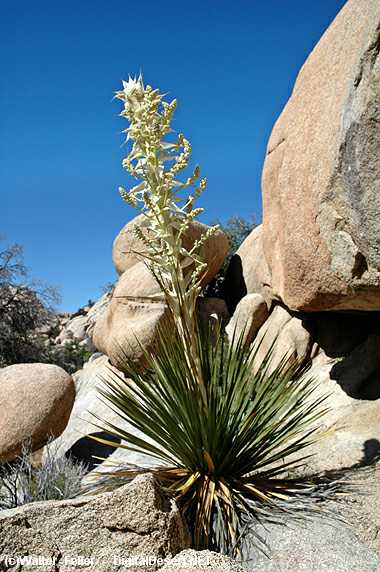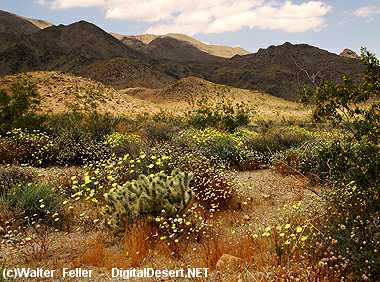Plant Adaptations
Xerophytes are plants that have developed special means of storing and conserving
water. To reduce transpiration, direct cooling air flow, shade themselves, and/or
reflect hot sunlight, they often have few leaves, or have spines, thorns, or hairs
instead; in some cases they use only their green “skin” to perform
photosynthesis. Some
xerophytes have leaves that are tough and waxy or coated with shiny oils, which
also cuts down on transpiration, or they have small, fluttery leaves that help to cool
the plants. Some species have spongy, shallow roots to take advantage of even the
smallest amounts of rain, plant tissues that can store large amounts of water for
later use, or ribs that direct moisture to the plant’s roots. The Joshua tree
(Yucca brevifolia),
various types of
cacti,
and Mojave sage (Salvia mojavensis) are all examples of Mojave xerophytes.
Phreatophytes are plants that grow extremely long roots, called tap roots, that allow them to
obtain water from deep in the ground.
Mesquites (Prosopis sp.)
have the longest tap root of any
desert species; it may reach down 25 m. The
creosote bush (Larrea tridentata)
is one of the most
successful of all desert species because it uses a combination of several adaptations, including
a deep tap root, a shallow root system, and wax-coated leaves that close their pores during the
day to avoid loss of water. The creosote bush has the added advantage of being both bitter-smelling
and -tasting; most
animals
won’t eat it, and other plants often won’t even grow near it, reducing
competition for water.
Desert perennials survive by remaining dormant during dry periods of the year, then
“coming back to life” when water becomes available. For example, the
ocotillo (Fouquieria splendens) grows leaves quickly after a rain to produce food through
photosynthesis. In a few weeks, ocotillo flowers bloom, seeds ripen and fall, leaves
drop, and the plant becomes dormant once more. Ocotillo stems also have a waxy coating
to help conserve water during dormancy. Other perennials include brittlebush (Encelia farinosa),
some varieties of
California poppy (Eschscholzia californica),
and desert paintbrush (Castilleja angustifolia), a
parasitic
plant that appropriates water from its host. By
contrast, annuals, or
ephemerals,
germinate only after a heavy rain, and then complete their
reproductive cycle very quickly to capitalize on optimal heat, light, and moisture conditions.
They bloom profusely for a few days or weeks in the spring, and then die, leaving their drought-resistant
seeds in the desert soils until the next spring rains. Annuals are responsible for the colorful desert
wildflower displays
that often appear in spring. Examples of such
wildflowers
are
sand verbena (Abronia villosa),
Mojave aster (Xylorhiza tortifolia), and
dune evening primrose (Oenothera deltoides).
Generally, thousands of
annual
and
perennial
seeds can be found in every handful of desert soil; the world
record is over 200,000 seeds per square meter, though the Mojave’s soils contain far fewer.
Also see:
Adaptations Summary
Desert Plants
Examples of Plant Adaptations

Parry nolina has adapted short roots for survival

Annuals are responsible for springtime wildflower displays